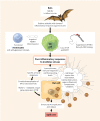Asymptomatic SARS-CoV-2 infection: is it all about being refractile to innate immune sensing of viral spare-parts?-Clues from exotic animal reservoirs
- PMID: 33289808
- PMCID: PMC7799061
- DOI: 10.1093/femspd/ftaa076
Asymptomatic SARS-CoV-2 infection: is it all about being refractile to innate immune sensing of viral spare-parts?-Clues from exotic animal reservoirs
Abstract
A vast proportion of coronavirus disease 2019 (COVID-19) individuals remain asymptomatic and can shed severe acute respiratory syndrome (SARS-CoV) type 2 virus to transmit the infection, which also explains the exponential increase in the number of COVID-19 cases globally. Furthermore, the rate of recovery from clinical COVID-19 in certain pockets of the globe is surprisingly high. Based on published reports and available literature, here, we speculated a few immunovirological mechanisms as to why a vast majority of individuals remain asymptomatic similar to exotic animal (bats and pangolins) reservoirs that remain refractile to disease development despite carrying a huge load of diverse insidious viral species, and whether such evolutionary advantage would unveil therapeutic strategies against COVID-19 infection in humans. Understanding the unique mechanisms that exotic animal species employ to achieve viral control, as well as inflammatory regulation, appears to hold key clues to the development of therapeutic versatility against COVID-19.
Keywords: COVID-19; SARS-CoV-2; asymptomatic; evolution; monocytes; origin.
© The Author(s) 2020. Published by Oxford University Press on behalf of FEMS.
Figures


References
Publication types
MeSH terms
Substances
Grants and funding
LinkOut - more resources
Full Text Sources
Medical
Miscellaneous

